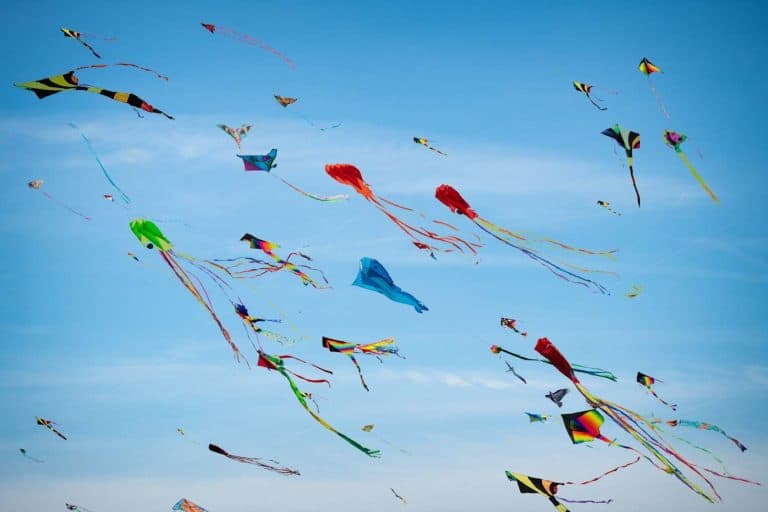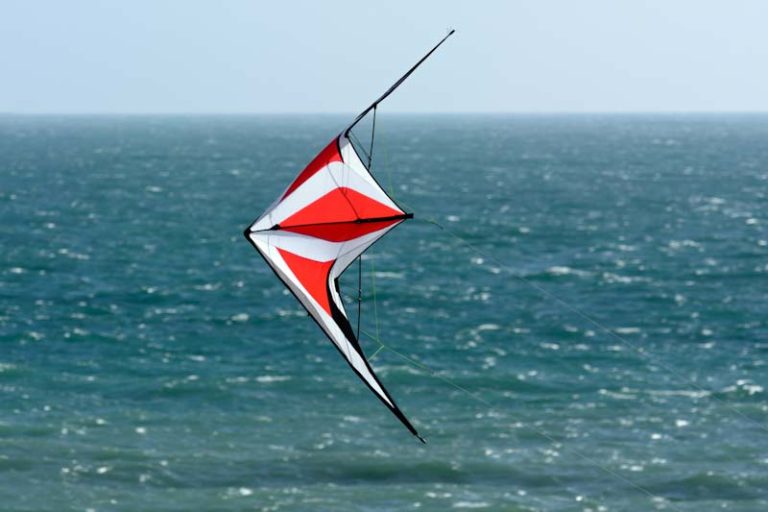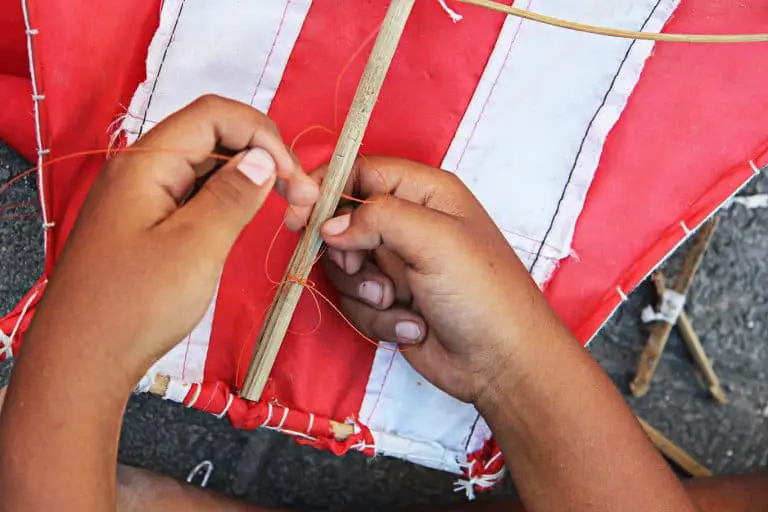What Is A Diamond Kite, And Are They Any Good?
Diamond kites have been one of the most common kites known to all. All ages from around the world can fly a diamond kite, and what’s more, is that you can even make one. It is because they are easy to make. The materials can be found at home and can use recycled parts to make a diamond kite.
This traditional kite has been around for ages, and when you hear the word kite, you’ll probably associate it with diamond-shaped kites. Diamond kites vary in size, color, materials, and style. We can’t deny that humans are always up for innovations and developments; therefore, diamond kites use quality materials that don’t disappoint.
Another convenient fact is that diamond kites can be purchased online or in physical stores without much hassle on your part as a buyer. Some kite makers even make sure to reach out to you regarding customization. Diamond kite’s parts are available anywhere. Local and vintage stores even display day-old diamond kites—cherishing the good old days.
Why Is A Diamond Kite Good?
There are multiple reasons why a diamond kite is good. But diamond kites have been the go-to kites because of their stable, beginner-friendly, and reliable flying features. It’s suitable for those who want to try kite flying as a beginner. Aside from that, you can build your diamond kite made of recycled and unused house materials like cotton, wooden dowels, fishing lines or strings, and school glue.
Where Did The Diamond Kite Originate?
Wolfgang’s The First Kiteman
We already have the slightest idea of how diamond kites are made. Now, let’s deep dive into where the first-ever kite originated. According to ancient records, the first-ever kite was made during the Mesolithic period. Experts dug through the caves in Muna Island, Southeast Sulawesi, Indonesia.
This discovery by Wolfgang Bieck was written in a German magazine with the title, “The First Kitman.” Many believe that the cave drawings date back to about 9,000 to 9,5000 BC. This cave drawing was a depiction of a man flying a kite. From there on, Wolfgang Bieck—a kite lover and expert—declared Kaghati the world’s first kite. (source)
Despite Kaghati being the declared world’s first kite, there is no complete historical record about Kaghati. However, it can still be declared the world’s first kite.
Kaghati’s Unique Materials
Kaghati is a traditional kite of Sulawesi people and is local on Muna Island. It is a unique kite since it contains dry leaves and bamboo sticks. It is because the materials are accessible around Muna Island.
The Kaghati kite uses a specific kind of leaves. These leaves are kolope leaves. In addition, it is combined with bamboo skins as the frame with looped pineapple fibers as rope or string to move around the Kaghati in the wind. Just like modern kites, Kaghati is crafted in different sizes based on the maker’s preferences.
If you’re wondering if the Kaghati kite is durable due to its components, don’t worry since the kite is sturdy. This kite can soar through high winds and last in the air for an extended period of days. The reason why Kaghati can withstand strong winds is because of its leaf arrangement. It is crafted to resist water and strong wind.
Kaghati’s Tie to Sulawesi People
The Kaghati kite is on Muna Island, and many locals fly the Kaghati for seven consecutive days. Many believe that the ancestors of the Muna people flew Kaghati as a spiritual method. It is a way of guiding the owner’s soul to God. After seven days of lying, the Muna people will cut the rope connected to the Kaghati.
At another time, when Islam penetrated Sulawesi Island, the Kaghati spiritual practice changed into entertainment. The Kaghati kite has soared during the grand harvest, around June to September, mainly because these months have ideal weather for flying the Kaghati.
Despite the Kaghati being known in small places before, it has been an eye-catching interest of Europeans because of the Kaghati’s durability and creativity.
Kaghati And World Records
Despite Kaghati’s local history, it has moved through the Guinness World of Records. The Kkitemade of kolope leaves could fly for more than 20 minutes which was the stated condition to attain the Guinness World Records.
The kite made of kolope leaves soared through the winds at the Jakarta City Arena on October 8, 2016. The La Masila, La Masili, Laode Pemesu, and La Negra kite makers built a 5 x 4.3 meters kite on October 8, 2016. The giant kite was able to soar successfully.
China And Kites
The Chinese philosophers Mozi and Lu Ban have been claimed as the inventors of kites in the last 5th Century. The materials are silk fabric and bamboo sticks for its frames. During 549 AD, paper kites were flown for rescue missions and sending out war information.
In another account, kites helped measure the distance, test the wind, and use for military operations. The earliest noted kites were flat and rectangular in dimensions and shapes. Later, kites had no tails for a more stable flight. It has a mythological and legendary figure for decoration and whistles to make sounds while in flight.
India’s Fighter Kites
When the kites first made their way to India, they transformed into fighter kites, known as Patang. These kites were flown yearly during the Makar Sankranti festival. This festival is as welcoming the longer days of the Sun, harvest festival, and Sun worships. (source)
Ancient Māori Kites
As far as historical records claim, kites spread throughout Polynesia—mainly in New Zealand. The knowledge about kites presumably originated in China through diffusion. The kites made of cloth and wood were used for religious ceremonies to send prayers to the gods.
Manufacturing kites in Ancient Māori was considered a sacred and time-consuming affair that only a tohunga—priest—of powerful tribes could craft kites. Food was not allowed to be ingested or consumed during the construction process. Then, the final flight was the responsibility of the tohunga or powerful tribal figures.
Legends in the ancient Māori stated that kites were the direct descendants of the GodGod of the birds. The legends emphasized the conquests of warriors and priests to escape from enemies during wars.
The Māori Kites reflected the physical features of their subjects and bestowed mystical relevance. The kites mimicked birds, men, or gods. These became a connection with the great powers that ruled their life.
Kites Fast-Forwarding To The 20th Century
After the diffusion of the knowledge of kites from Indonesia to Europe, manufacturers updated the kites’ designs. Among the development and innovation were Eddy’s tailless diamond, the Rogallo wing, sled kite, parafoil, and power kites.
In some instances, kites were utilized for scientific discoveries and mostly integrated into meteorology, aeronautics, wireless communications, and photography. During World War II, the military saw that it was somewhat inefficient to use kites for military purposes in terms of the military radio antenna kites.
Radio antenna kites helped carry a radio antenna to higher places. The utilization of kite antenna was challenging due to external and environmental factors like consistent antenna height, wind unpredictability, radio transmissions, and receptions.
As years go by, kites are only for recreational activities. Kites can go in different designs, colors, sizes, and shapes, but the most common are diamond kites.
What About Diamond Kites?
Diamond kites are the most popular kites all over the world. It is because these kites can be made or designed in the comfort of your home. Who wouldn’t want that, right? It’s such a tedious process driving to stores to purchase a kite or even browse online before choosing the best one.
Regardless of your preferences in terms of Diamond kites, diamond kites have been with families’ and friends’ bonding and moments. It may be a universal experience for everyone to experience flying a kite or even making one. Well, it goes to say that we’re all connected by kites so far.
These diamond kites can vary in size from 5 feet or more. In this context, all ages can experience the fun of flying a diamond kite. There may be times that diamond kites may come with a tail or none at all. It depends on your preferences; you can always add a tail if you want one. Simply saying, the possibilities are—at least—endless with diamond kites.
To give you an idea, here are the different Amazon diamond kites you can easily purchase and deliver to your doorstep with just one click.
Kiting Planet is an Amazon Associate. As an Associate, I earn from qualifying purchases.
In The Breeze Red 30-Inch Diamond Kite – Single Line – Ripstop Fabric – Includes Kite Line And Bag – Great Entry Level Kite, 2988
The Breeze’s 30-inch Purple Diamond kite is easy to launch and fly. The assembly guide is simple and direct. This kite is suitable for beginners and children and above. It has a lightweight material that is durable with a reusable kite bag for protection. You can use this kite for a 6 to 20-mph wind range.
- Size: 30 inches wide by 30 inches by height
- Shape: Diamond
- Materials: Ripstop polyester
Large Rainbow Diamond Kite For Kids Easy To Fly
Description: AGREATLIFE Store’s Large Rainbow Diamond Kite has always been around to give family and friends the time to bond and cherish the moments. The main goal of AGREATLIFE is to create moments without breaking the bank. These kites are suitable for kids and beginner adults with a lifetime warranty to ensure you’ll enjoy flying a kite with your loved ones for a long time.
- Size: 48 inches
- Shape: Diamond
- Materials: Polyester
YANGJIABU’s Kite For Kids Adults
Description: YANGJIABU’s Multi Color Kite has an upgraded anti-tear feature that is more resistant to harsh abrasion and tearing. This kite has a comfortable grip and 328 feet of string to glide your kite to bigger heights. It contains non-burr fiber reinforced plastic frames for durability and long-term use. Adults and below can use it.
- Size: 42.5 x 45 inches
- Shape: Diamond
- Materials: Polyester
DIY Kites For Kids Kite Making Kit Bulk, Decorating Coloring Kite Party Pack, White Diamond Kite Kits (6 Pack)
Description: Mint’s Colorful Life Store ensures that not all kites are similar. In this case, they provided DIY kites for kids and adults. These six blank diamond kites are ready to be personalized based on your unique creativity. It’s great for many occasions and can also be a school project. They say, “Making your kite and flying is a more rewarding experience!”
- Size: 25 x 25 x 0.1 inches
- Shape: Diamond
- Materials: Thin polyester
Why Is A Diamond Kite Good?
William A Eddy popularized them in 1893. Diamond-shaped kites are the easiest kite to fly and launch and are usually suitable for kids and beginner adults. The reason is that diamond kites are reliable, stable in flight, and easy to launch.
That’s why kite lovers often recommend flying diamond kites at the beginning stage of kite-flying. Aside from that, you can build diamond kites using at-home materials like paper, plastics, or thin cotton materials. You can also use wooden or bamboo sticks and dowels as the spine that will hold the frame in shape. (source)
Reasons Why A Diamond Kite Is Good
- Reliability
- Stability
- Easy-to-launch characteristics
- Easy-to-find materials
Pros Of Flying A Diamond Kite
Let’s gloss over the brief advantages and benefits of flying a diamond kite. Here is what you need to know about its benefits:
Diamond Kites Are A Head-Turner
You can personalize diamond kites based on your preference or creative pursuit. More so, you don’t need to purchase expensive and hard-to-find materials. It is because you can easily find at-home materials if you want to build your diamond kite.
Diamond Kites Are Generally Small
The smaller the kite, the easier it is to launch and move. You will not have a challenging time maneuvering your diamond kite when up in the skies. Therefore, this is good for beginners and kids. In other words, an excellent start to accomplish the finish line.
Diamond Kites Are Stable
If you are still on the stage of practicing kite-flying, it’s best to select diamond kites as your first kite. The reason is that diamond kites are stable and balanced in flight. There’s no fuss or hassle since the spinning and crashing are limited.
Diamond Kites Can Be Made At Home
Nothing’s wrong with being a cheapskate. In this economy, who wouldn’t be one1? So, if you want to save money, you can make diamond kites without buying costly materials or even purchasing ready-made ones in stores. You can watch multiple tutorials if you’re going to make your diamond kite.
Diamond Kites Are Easy To Repair
Diamond kites can be repaired. For instance, if your diamond kite is out of balance or spinning sporadically, you can always add a tail to balance it out.
What Should I Look For In A Diamond Kite?
Knowing the best and quality materials in a diamond kite is vital if you want to buy a kite instead. In all actuality, diamond kites use durable materials. However, how do we know if a diamond kite has suitable materials? In this part, here are what you need to look for in a diamond kite:
Ripstop Nylon Or Polyester
Manufactured diamond kites should at least use ripstop fabric. It is because these types of cloth can endure harsh abrasion and friction. For instance, when you crash your kite, there’ll be no tears caused by the crashes. Therefore, looking for ripstop fabrics in the kite’s sail is best.
Fiberglass Rods
Fiberglass is known to be durable and can withstand hard crashes or bumps. If that’s the case, looking for diamond kites with these rods is recommended. It ensures that you can use your kite for a very long time.
Water-Resistant Feature
Kites should be able to fly as much as possible; however, if your kkiteis drenched, it will be heavier than its average weight. Therefore, you’ll have difficulty launching or even flying your kite instability. So, choosing a water-resistant kite is recommended.
Tails
Diamond kites are usually flat. Hence, there’ll be chances of sudden crashes and spinning on air. To avoid these issues, make sure that your kite should have tails included. The tails can balance your kite’s flight with no problems and reduce the chances of spinning and crashing.
Lifetime Warranty
It is optional, but it’s best to secure it with a client-supported policy. You may make your kite with durable and lightweight materials, but consecutive use can wear off its performance and material quality. That’s why looking for a lifetime warranty on your diamond kite purchase is better.
Final Thoughts
Diamond kites are good, especially if you are just beginning to find interest in kite-flying. The reasons are:
- Reliable and a go-to kite for over centuries.
- Stable in flight and has no problem with incessant crashing or spinning.
- You can find materials in the comfort of your home and accessible supply stores.
- Easy to fly since it has a more stable feature and performance.
If you want a rather laid-back kite-flying experience with a few sprinkles of thrill from here or there, you can opt for diamond kites first before moving to the bigger and more challenging kites. Besides, every pro-kite-flier started at the beginning, so there’s no shame in that! What matters is you enjoyed kite-flying!
So, are diamond kites any good?
Yes, and yes! Diamond kites are good on any occasion. Also, it is tied to rooted culture and practices that you can highlight. In this case, fly your diamond kite and begin conquering the skies on land!
Do you have something to share about diamond kites? Comment down below!
Did this article help you with diamond kites? Like and share it with your friends!
Sources
- British Telecommunications. “British Telecommunications.” teaching.shu.ac.The UK, July 1, 1997. https://teaching.shu.ac.uk/ds/rdp/window/kites/ki_about.htm.
- Science Monitor, The Christian. “A Short History of Kites – CSMonitor.Com.” The Christian Science Monitor. www.csmonitor.com, March 2, 1999. https://www.csmonitor.com/1999/0302/p22s2.html#:~:text=Kites%20first%20appeared%20in%20Asia,tyrannical%20emperor%20in%20200%20BC.
- Tarlton, John. “Art New Zealand.” Art New Zealand. www.art-newzealand.com, December 3, http://www.art-newzealand.com/Issues1to40/kites.htm.
- Subarkah, Taufik. “Ketika Khagati Kolope Terbesar Mengudara.” tirto.id. tirto.id, October 30, 2016. https://tirto.id/ketika-khagati-kolope-terbesar-mengudara-bYVp.
- Go Celebes. “Kaghati, World’s First Kite | Go Celebes.” Go Celebes | Tourism, and Destination of Sulawesi Island of Indonesia. en.gocelebes.com, March 4, 2013. https://en.gocelebes.com/kaghati-worlds-first-kite/.
- Best Breezes. “BEST BREEZES: Kites and Kite History – William Abner Eddy – Diamonds in the Sky.” BEST BREEZES: Kites and Kite History – William Abner Eddy – Diamonds in the Sky. best-breezes.squarespace.com, October 1, 1991. http://best-breezes.squarespace.com/william-abner-eddy/.
- Aprilisa , Ema . “Kaghati, Layang-Layang Pertama Di Dunia Ternyata Berasal Dari Indonesia!” teen.co.id. web.archive.org, April 19, 2017. https://web.archive.org/web/20171211053339/https:/www.teen.co.id/read/4130/kaghati-layang-layang-pertama-di-dunia-ternyata-berasal-dari-indonesia.
- Melton, J. Gordon. “Religious Celebrations.” Google Books. books.google.com.ph, 0 0, 2011. https://books.google.com.ph/books?id=KDU30Ae4S4cC&pg=PA547&redir_esc=y#v=onepage&q&f=false.
- Science Monitor, The Christian. “A Short History of Kites – CSMonitor.Com.” The Christian Science Monitor. www.csmonitor.com, March 2, 1999. https://www.csmonitor.com/1999/0302/p22s2.html#:~:text=Kites%20first%20appeared%20in%20Asia,tyrannical%20emperor%20in%20200%20BC.
- Kite Month. “Kite History.” Kite History. www.nationalkitemonth.org, April 2021. https://www.nationalkitemonth.org/kite-history-overview/kite-history/.







